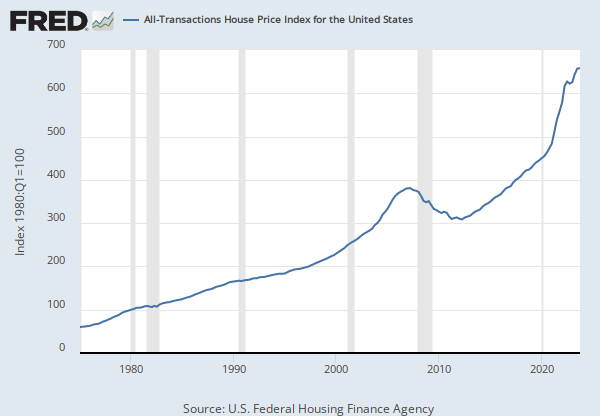Federal Reserve Economic Data
Data in this graph are copyrighted. Please review the copyright information in the series notes before sharing.
Notes
Source: U.S. Census Bureau
Source: U.S. Department of Housing and Urban Development
Release: New Residential Construction
Units: Thousands of Units, Seasonally Adjusted Annual Rate
Frequency: Monthly
Notes:
As provided by the Census, start occurs when excavation begins for the footings or foundation of a building. All housing units in a multifamily building are defined as being started when this excavation begins. Beginning with data for September 1992, estimates of housing starts include units in structures being totally rebuilt on an existing foundation.
Suggested Citation:
U.S. Census Bureau and U.S. Department of Housing and Urban Development, New Privately-Owned Housing Units Started: Total Units [HOUST], retrieved from FRED, Federal Reserve Bank of St. Louis; https://fred.stlouisfed.org/series/HOUST, .
Source: Board of Governors of the Federal Reserve System (US)
Release: Z.1 Financial Accounts of the United States
Units: Billions of Dollars, Not Seasonally Adjusted
Frequency: Quarterly, End of Period
Notes:
Source ID: FL155035065.Q
For more information about the Flow of Funds tables, see the Financial Accounts Guide.
With each quarterly release, the source may make major data and structural revisions to the series and tables. These changes are available in the Release Highlights.
In the Financial Accounts, the source identifies each series by a string of patterned letters and numbers. For a detailed description, including how this series is constructed, see the series analyzer provided by the source.
Suggested Citation:
Board of Governors of the Federal Reserve System (US), Households; Owners' Equity in Real Estate, Level [OEHRENWBSHNO], retrieved from FRED, Federal Reserve Bank of St. Louis; https://fred.stlouisfed.org/series/OEHRENWBSHNO, .
Source: S&P Dow Jones Indices LLC
Release: S&P Cotality Case-Shiller Home Price Indices
Units: Index Jan 2000=100, Seasonally Adjusted
Frequency: Monthly
Notes:
For more information regarding the index, please visit Standard & Poor's. There is more information about home price sales pairs in the Methodology section. Copyright, 2016, Standard & Poor's Financial Services LLC. Reprinted with permission.
Suggested Citation:
S&P Dow Jones Indices LLC, S&P Cotality Case-Shiller U.S. National Home Price Index [CSUSHPISA], retrieved from FRED, Federal Reserve Bank of St. Louis; https://fred.stlouisfed.org/series/CSUSHPISA, .
Release Tables
Related Data and Content
Data Suggestions Based On Your Search
Content Suggestions
Other Formats
New Privately-Owned Housing Units Started: Total Units
Monthly, Not Seasonally AdjustedHouseholds; Owners' Equity in Real Estate, Level
Millions of Dollars, Annual, Not Seasonally AdjustedS&P Cotality Case-Shiller U.S. National Home Price Index
Monthly, Not Seasonally AdjustedRelated Categories
Releases
Tags
Permalink/Embed
modal open, choose link customization options
Select automatic updates to the data or a static time frame. All data are subject to revision.































